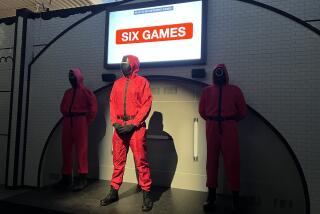‘Multi-Player’ Is the New Game in Town : Industry Introduces Innovations at E3
- Share via
Time is running out. You’ve failed to outgun the enemy and grab the coveted “crystal,” and you are about to be blown to smithereens. But wait--all isn’t lost. Your best friend, playing against you from his home across town, is also in the chamber. If you get close enough to him, he too will be destroyed in the blast.
“It’s much more exciting seeing your friend blown up,” says Activision Chief Executive Bobby Kotick, describing the attraction of the multi-player game Blast Chamber. It’s one of a barrage of online games being launched this week as part of the Electronic Entertainment Exposition at the Los Angeles Convention Center.
For serious gamers, matching wits with other gamers has always been considered the ultimate game experience. But limited choice and sluggish response times over telephone lines has restricted online playing to a privileged group of serious gamers, many of whom have access to high-speed corporate computer networks.
But now the incredible growth of the Internet computer network has helped speed the development of new multi-player games and advanced online game services that the industry hopes will rejuvenate the sluggish industry.
“Multi-playing is the shot in the arm that takes gaming to a whole new level,” says Jack Heistand, chief executive of San Francisco-based Total Entertainment Network.
Both Heistand’s company and Cupertino, Calif.-based MPath Interactive are launching national services this week that will allow gamers to play a wide range of personal computer games over the Internet. Interplay Productions of Irvine recently spun off its Engage Games Online division and announced plans to build up an aggressive lineup of new multi-player offerings.
Sega, whose Saturn video game console is losing out in the war with Sony and Nintendo, announced plans to offer a modem attachment to allow online gaming, and struggling 3DO recently purchased online game developer Archetype Interactive Corp.
“What consumers really want out of the Internet is entertainment,” says Mike Ribero, Sega’s top marketer. “Being able to play people when they can’t see you touches people’s voyeuristic side.”
Meanwhile, software developers are incorporating multi-playing capability into most of their games to allow for online playing.
“It’s a key selling point for sports games, strategy games and action arcade-style games,” says Rand Bleimeister, senior vice president of sales at Virgin Interactive.
Virgin’s recently released strategy game, Command and Conquer, is a popular multi-player game offered on many online services. The company is also working on a game called Sniper that could be loaded on a central computer and allow consumers to play without actually buying a CD-ROM.
Some of the more sophisticated online games involve exploring cyberworlds. MGM Interactive this week is showing work it is doing with a French developer on Second World, a sophisticated “world” that included a lifelike depiction of Paris that players can roam through as they take on such legendary demons as the Phantom of the Opera. Players’ “avatars,” or representations, can be built up from a palette of racial and ethnic choices, fashion looks and body types.
*
Ron Frankel, general manager at MGM Interactive, notes that 60% of America Online’s usage is in chat rooms. Role-playing worlds, which incorporate chat rooms, he argues, are a logical extension of that.
All the hype aside, though, some analysts are still skeptical. Dataquest multimedia analyst Bruce Ryon predicts that multi-player online games won’t hit the mass market “until the next millennium,” because of the difficulty of replicating true social interactions online.
To play in cyberspace, gamers must first dial into the service, which then matches them up with others who want to play the same game. Once in the game, they communicate with other players--either teammates or opponents--by typing messages.
While all of this can be cumbersome, some of the obstacles are coming down. Improved graphics, which include the ability to change expressions on faces, certainly helps. And MPath’s new service allows players to talk to each other over the network as they play.
In a flight simulation game, for example, the pilot would be able to talk to his wing man, squadron headquarters and select members of the enemy. Those playing the shoot-’em-up game Doom would be able to talk to their team members as they go about mowing down the enemy.
MPath’s system also reduces the lag time between when a game action is initiated and when it actually happens--a major issue for serious gamers. Rather than relying on random Internet links, MPath places computers all over the country and assigning gamers to the one closest to them.
MPath Chief Executive Paul Matteucci said his company expects to have 20,000 to 30,000 subscribers by year-end paying $10 to $15 a month for five hours of gameplay.
TEN, which got an earlier start, already has 4,000 players using a test version. On Monday, its system went national, allowing players all over the country to play with each other.
*
But skeptics say the online game marketing won’t really explode until even the so-called twitch games--fast-action fighting games--can be played online using off-the-shelf software.
“It’s like the difference between watching a documentary and an action adventure . . . the difference between PBS and MTV,” says 24-year-old Brian Morrison, a Woodland Hills resident and serious online gamer.
“What people want is the same playability online as they get with single player,” Morrison says.
* GAME SUBCULTURE
Expo attracts a diverse mix of people. B1
More to Read
The biggest entertainment stories
Get our big stories about Hollywood, film, television, music, arts, culture and more right in your inbox as soon as they publish.
You may occasionally receive promotional content from the Los Angeles Times.










